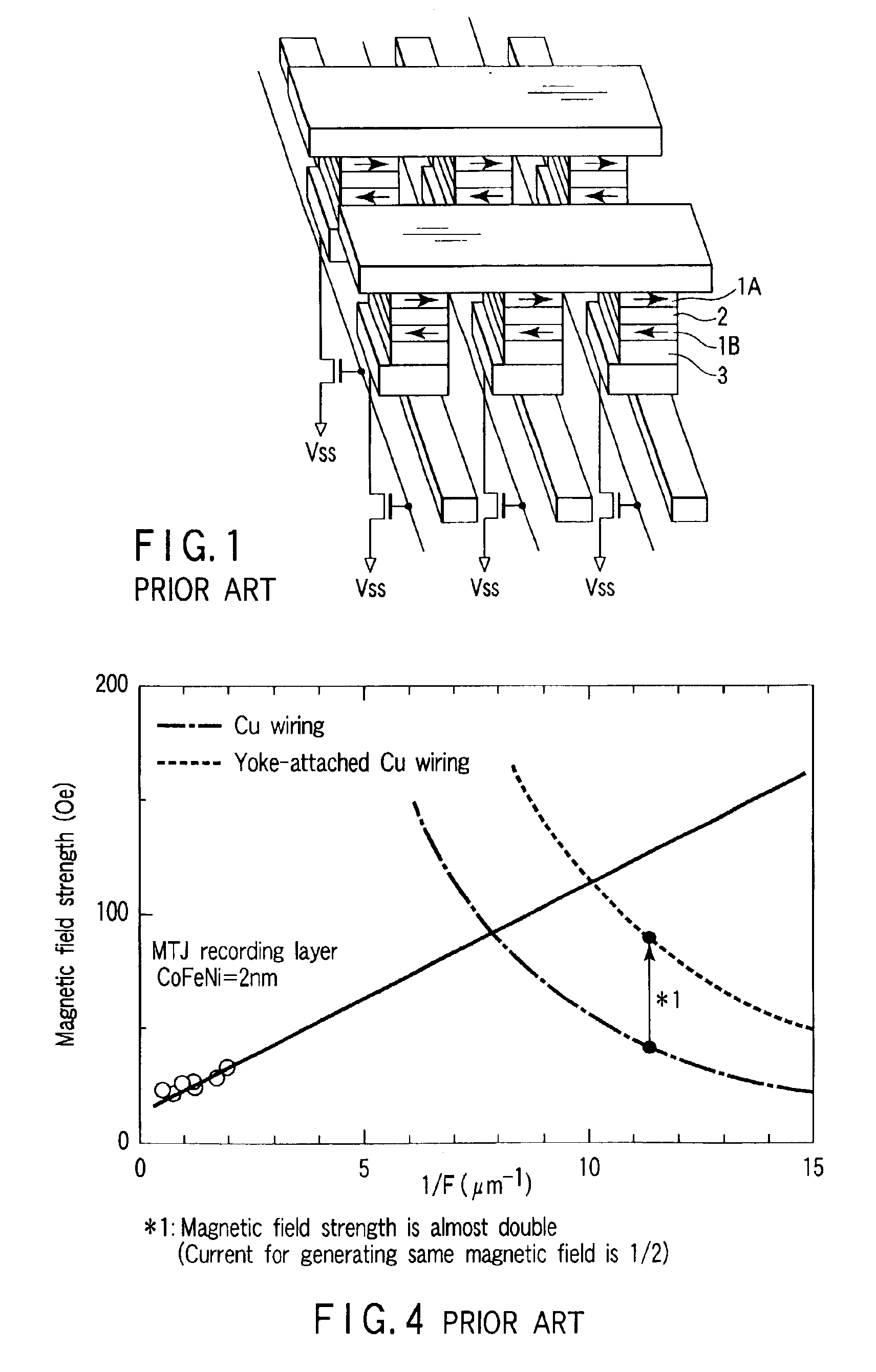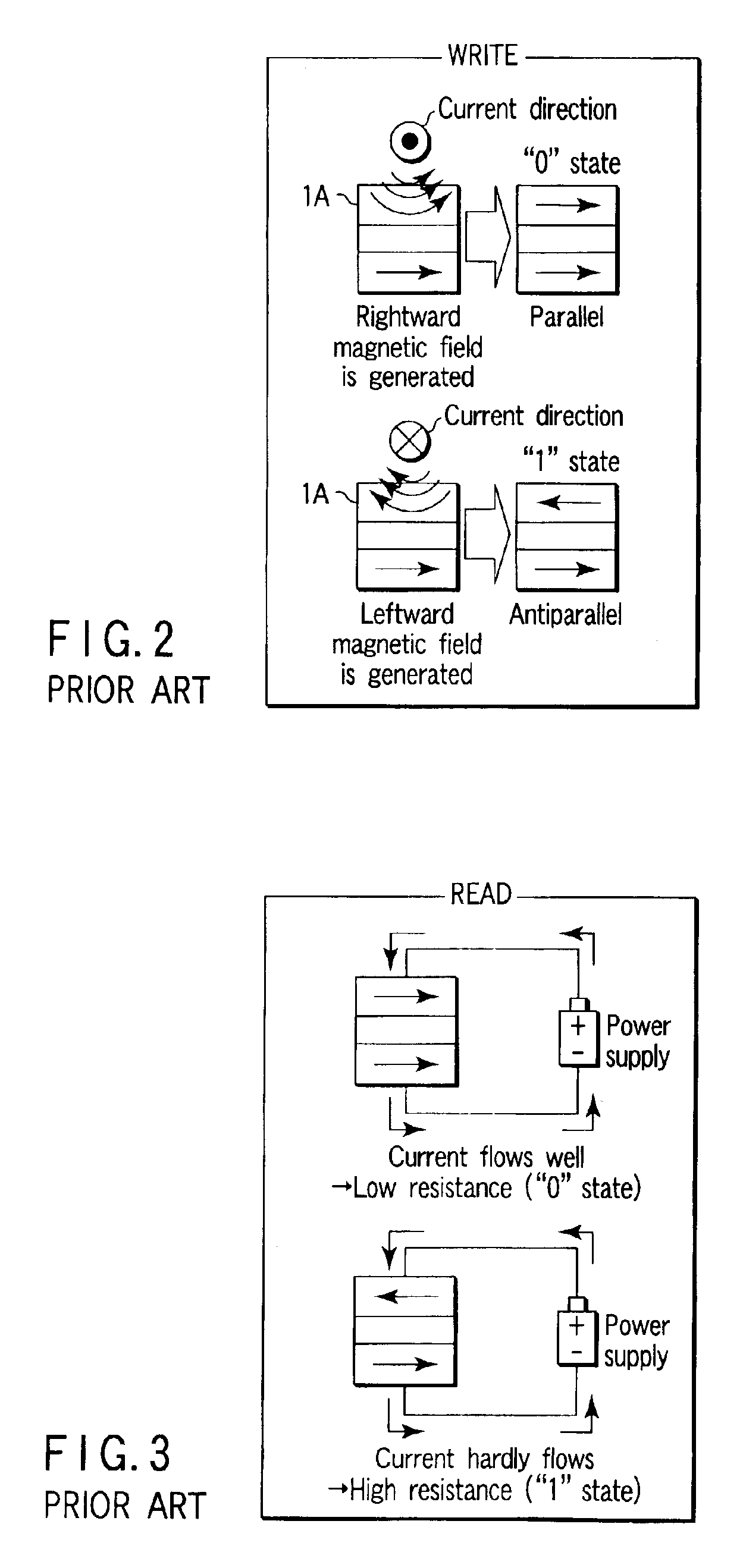Magnetic random access memory
- Summary
- Abstract
- Description
- Claims
- Application Information
AI Technical Summary
Benefits of technology
Problems solved by technology
Method used
Image
Examples
first embodiment
2. First Embodiment
[0082]FIG. 6 shows the device structure of the main part of a magnetic random access memory according to the first embodiment of the present invention. FIG. 7 is a perspective view three-dimensionally showing the structure of FIG. 6.
[0083]A write line 4 runs along the X-axis, and a write line 5 runs along the Y-axis. The write lines 4 and 5 are made of, e.g., Cu. An MTJ element 6 is arranged at the intersection of the two write lines 4 and 5 crossing each other. The MTJ element 6 has a rectangular shape which is long along the X-axis and short along the Y-axis. In this case, the easy axis of magnetization of the MTJ element 6 is the X-axis.
[0084]The MTJ element 6 is made up of, e.g., a recording layer (magnetic layer) 1A, fixed layer (magnetic layer) 1B, tunneling barrier layer 2, and antiferromagnetic layer 3. The antiferromagnetic layer 3 of the MTJ element 6 is arranged on the write line 4 side. The antiferromagnetic layer 3 is made of, e.g., PtMn or CoFe. The ...
second embodiment
3. Second Embodiment
[0091]FIG. 8 shows the device structure of the main part of a magnetic random access memory according to the second embodiment of the present invention.
[0092]The device structure of the second embodiment is different from that of the first embodiment in that the X-axis (easy axis of magnetization) end of an MTJ element 6 is in contact with a yoke material 8. In this case, the recording layer of the MTJ element 6 is exchange-coupled to the yoke material 8 on the lower and side surfaces. The remaining structure is the same as that of the first embodiment.
[0093]Also in the second embodiment, the total magnetic volume ΣMsi×ti of the recording layer of the MTJ element 6 and a portion of the yoke material 8 that is exchange-coupled to the recording layer is set smaller than the magnetic volume ΣMsi′×ti′ of the remaining portion of the yoke material 8 that covers a write line 5.
third embodiment
4. Third Embodiment
[0094]FIG. 9 shows the device structure of the main part of a magnetic random access memory according to the third embodiment of the present invention.
[0095]The device structure of the third embodiment is different from that of the second embodiment in that no yoke material exists immediately below an MTJ element 6, i.e., the lower surface of the MTJ element 6 is in contact with the upper surface of a write line 5 without the mediacy of any yoke material.
[0096]The MTJ element 6 is in contact with a yoke material 8 on only the X-axis (easy axis of magnetization) end. In this case, the recording layer of the MTJ element 6 is exchange-coupled to the yoke material 8 on the side surface. The remaining structure is the same as that of the second embodiment.
[0097]Also in the third embodiment, the total magnetic volume ΣMsi×ti of the recording layer of the MTJ element 6 and a portion of the yoke material 8 that is exchange-coupled to the recording layer is set smaller tha...
PUM
 Login to View More
Login to View More Abstract
Description
Claims
Application Information
 Login to View More
Login to View More - R&D
- Intellectual Property
- Life Sciences
- Materials
- Tech Scout
- Unparalleled Data Quality
- Higher Quality Content
- 60% Fewer Hallucinations
Browse by: Latest US Patents, China's latest patents, Technical Efficacy Thesaurus, Application Domain, Technology Topic, Popular Technical Reports.
© 2025 PatSnap. All rights reserved.Legal|Privacy policy|Modern Slavery Act Transparency Statement|Sitemap|About US| Contact US: help@patsnap.com



